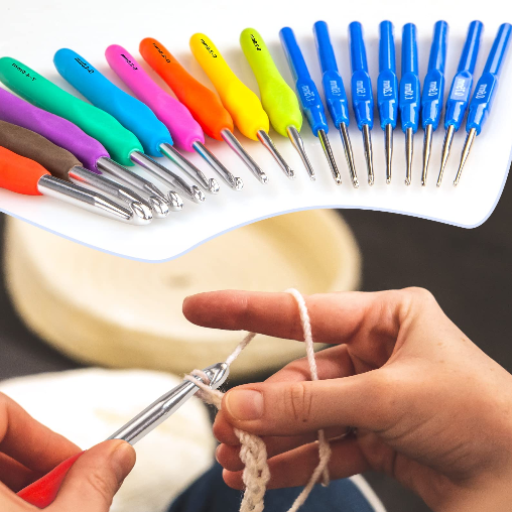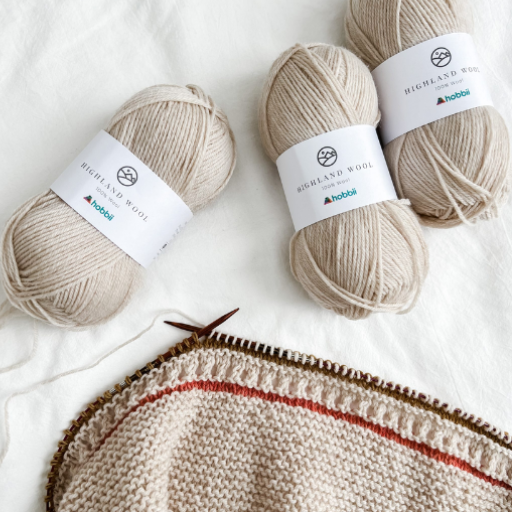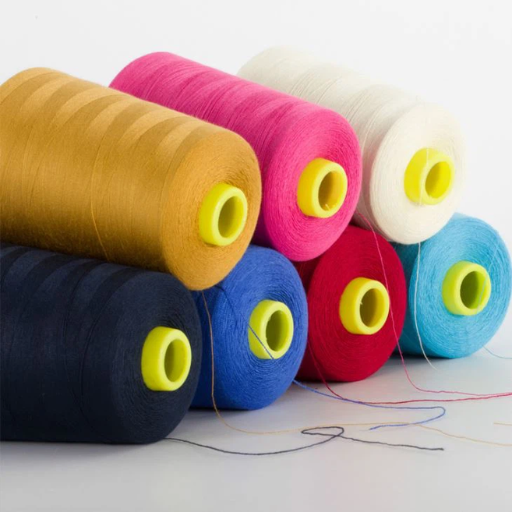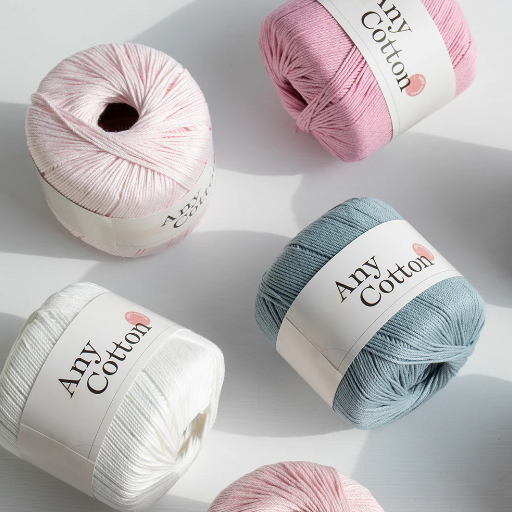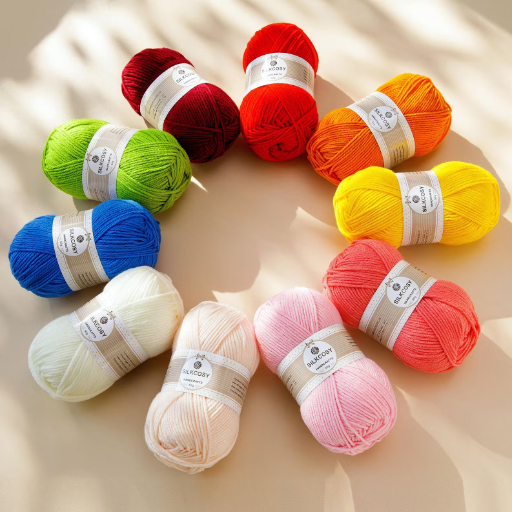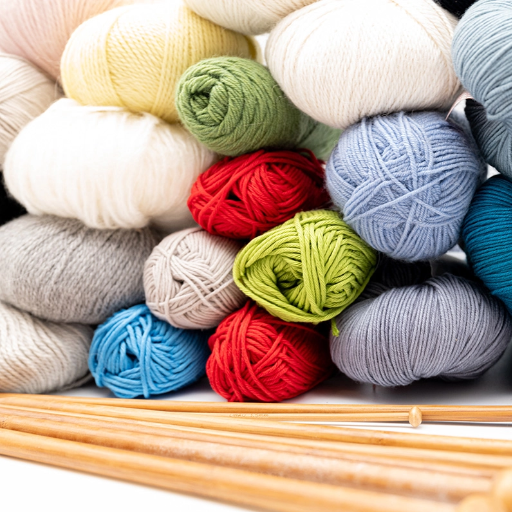As with any craft, the aesthetics and functionality of the final product begins with the correct yarn selection. From garments to elaborate models, their demands lead them to prefer worsted weight acrylic yarn due to its strength and versatility. In this article, we investigate the properties of acrylic yarn, what sets it apart, its pros, and how to find the best options, for your next project. We explore the brand comparisons accompanied by practical considerations like ease of use, affordability, and care instructions, providing you with the most informed guidance possible. Knitters, crocheters, and all fiber artists alike are guaranteed to walk away from this accomplished knowing how best to optimize their materials, improve their creations, and most importantly, enhance their craft.
What is Worsted Weight Yarn?

Worsted weight is extremely popular and frequently used yarn for different crafting, crocheting and knitting projects due to its medium weight. In terms of yarn categorization, it is designated as a four-yarn under the Craft Yarn Council’s Standard Yarn Weight System. Its thickness and flexibility makes it ideal for numerous items such as sweaters, blankets, scarves and even hats. As with other types of yarn, the gauge for worsted weight yarn generally works best with 5.5 mm to 6.5 mm needles or hooks, although tension and other project specifics have to be taken into account. Due to the structural attributes of worsted weight yarn, it allows the creation of sharply defined stitches which makes it easier to be used by novice crafters and seasoned experts alike.
Understanding yarn weight categories
The classification of yarn by weight defines the diameter of a yarn strand. This unique system has a range spanning from lace weight as the lightest, to jumbo weight as the heaviest, allowing flexibility for different crafting requirements. Each category of weight is aligned with a specific set of tools and projects
1. Lace Weight (0) – Very thin and delicate yarn which is suitable for doilies and shawls requiring intricate detailing. This is usually made with 1.5-2.25 mm needles/hooks.
2. Super Fine (1) – Sock yarn as well as other fine threads often used for light apparel. Usually associated with 2.25 mm to 3.25 mm needles/hooks.
3. Fine (2) – Generally associated with baby items and light accessories, fingering weight is worked with 3.25 mm to 3.75 mm needles/hooks.
4. Light (3) – Stretch yarn or DK (double knitting) is suitable for sweaters, baby clothes, and lightweight blankets. It needs tools ranging from 3.75 mm to 4.5 mm.
5. Medium (4) – Aran or worsted weight yarn is the most versatile as it can be used for almost all projects. It is used with 5.5 mm to 6.5 mm needles/hooks.
6. Bulky (5) – Used in scarves and afghans, this yarn is best suited for projects that need to be completed quickly. Best used with 6.5 mm to 9 mm hooks/needles.
7. Super Bulky (6) – Effective for heavy-duty items such as warm outerwear and rugs, masons tools ranging from 9 mm to 15 mm are required.
8. Jumbo (7) – Ususally worked with tools beyond 15 mm, this is the thickest category meant for oversized projects or arm knitting.
Knowing these categories helps guarantee optimal outcomes concerning texture and durability relative to your design alignment. For accuracy, always refer to the recommended needle or hook sizes and gauge swatches.
Characteristics of worsted weight yarn
This type of yarn is number 4 on the yarn weight system, meaning it is one of the most popular and versatile yarns known as “worst knitted yarn”. Its level of twist is neither too low or high, meaning that garments, accessories, and decorations can easily be created with it’s moderate thickness. Applying worsted weight yarn allows for precise stitch detailing, so textured patterns and designs become quite straightforward, adding depth and complexity to work. Both seasoned experts and crafters can easily use this versatile design enabling them to express their creativity using different molded fibers such as acrylic, wool, or even cotton spandex.
Differences between worsted and other yarn weights
Worsted yarn is different from other yarsn weights because it sits in the middle between DK (double knit) and heavier yarns like bulky or chunky. Worsted yarn projects are completed faster and are more structurally sound than DK projects because worsted yarn is thicker. However, lighter weights do provide more delicate drape, which is not available with worsted yarn. On the other hand, stronger than bulky yarn, worsted offers more versatility. Bulky yarn do tend to add stiffness and weight, but with worsted yarn, finished products retain a level of flexibility. As stated previously, stitches are formed using yarn with needles or hooks ranging from 4.5-5.5mm which is ideal for creating a worsted yarn. With them, heavier and lighter crochet yarns need larger and smaller tools respectively. Each of them with their unique characteristics have the ability to change the overall finish, use, and the end product.
Why Choose Acrylic Yarn for Your Projects?

The acrylic yarn has synthetic itself into the fabric of acrylic crafts due to its cost-efficiency and its non-natural fibers (synthetic acryl) nature. Its properties allow it to acrylic fiber, giving it enhanced durability with easy tear resistance, low weight, and ease of manipulation. Damaged. Even when cared for inadequately, like in the machine, acrylic yarns tend to preserve their aesthetics and structure, lasting, so their place is cemented in blankets, clothing, and most worn pieces of fashion. Furthermore, the arrays of brilliant nuances and vivid hues grant endless imagination with sparkly new patterns and unique designs.
Benefits of using acrylic yarn
- Affordability – Crafters on a budget do not have to worry with acrylic yarns because cost-effective solutions are now available. They are much cheaper than other natural fiber options, making them ideal for any project.
- Durability – Unlike natural fibers, acrylic yarns do not shrink, fade or peel. This ensures value over a long period of time while maintaining optimal results for any project.
- Low Maintenance – Cleaning is no longer a tough chore. Due to the synthetic build, they are tough and do not easily wear down over time, making the yarns machine washer friendly and quick drying.
- Wide Variety – Having fun with textures, colors and finishes while creating is simple now thanks to the ample stock available for affordable acrylic yarns which can serve as a great canvas for creativity.
- Lightweight Nature – Services and clothing for home décor do not have to be hard to wear thanks to lightweight acrylic yarns that add great style and strength.
- Hypoallergenic Properties – Compared to some other natural fibers, acrylic is less likely to trigger allergic reactions. This makes it more suitable for items of clothing and presents.
Comparing acrylic yarn with wool yarn
Acrylic fabrics alongside woolen, are different, as they serve unique needs and user preferences from both ends. As spelled acrylic yarn, it has been noted among fibers as the cheapest option, emphasizing strength and moth and moisture resistance for its protective properties. Furthermore, it does not fade when washed, retaining its dyes and textures, even with exposure to abrasive actions, and comes prepacked-modified to fit different styles. However, the twined fringe fabric, shredded from live-sheep fur, has different features, regarded for its elasticity, ability to breathe freely, and thermal insulation for its hailed sleeping properties. It prevents the body from freezing by cooling down while keeping warm, so exerts, on the downside, wool is softer and less durable, needing prone to more hand wash instead of dry and airman care to keep it whole.
Wool has a reputation for being biodegradable or eco-friendly, however, it’s acrylic yarn that takes hypoallergenic properties into consideration first. This is due to wool containing lanolin which allergic individuals can be sensitive to. On the other hand, while acrylic yarn is quite durable and lightweight, they lack the luxurious feel of wool which makes garments appealing. Therefore, in regards to high-end fashion, wool is the clear winner. For crafters and consumers, they have the ability to choose depending on their individual priorities, personal budgets, and application which makes the versatility phenomenal.
Cost-effectiveness of worsted weight acrylic yarn
The softness and luxurious feel wool garments come with is unmatched which is why people prefer it over acrylic. This said, there’s no denying that worsted weight acrylic yarn has set a benchmark in regards to construction as it is widely appreciated for being cheap; especially by budget conscious crafters. This is because compared to natural fibers such as wool, acrylic yarn is significantly cheaper due to its synthetic composition and mass production processes. Not only is it cost effective, stressing on best suiting crafters needs, but it’s also durable. Acrylic fibers are tear resistant which means finished projects stave off shape and appearance over time. For crafters who constantly need to maintain thier projects, the fact that vaious acrylic yarns retract from shrinkage and can be washed in machines goes a long way. Overall, the combination of low cost, cost free upkeep and elasticity renders worsted weight acrylic yarn a fantastic deal.
How to Select the Right Worsted Yarn for Crochet and Knitting?

Worsted yarn provides a range of options to use for crochet and knit projects, but the best fit can best be selected when the following points are considered:
- Fiber Content: Determine the type of fiber required for your project, whether it be natural, synthetic, or blended. Wool is a natural fiber that provides warmth and elasticity, while acrylic is synthetic and offers durability and easy maintenance.
- Texture and Softness: Check the yarn’s texture to ensure that it is appropriate for the intended use. For example, items designed for babies or other wearables require a high degree of softness.
- Yardage and Weight: Check if the amount of yarn in won’t two skeins of yarn is enough for your pattern. Ensure that both the length and weight of the yarn meets your pattern needs to avoid mid-project shortages.
- Color and Dye Lot: When changing skeins in the middle of the project, try to maintain the same color throughout. Keep note of the dye lot number of the colors you intend to use, so that you can switch colors without worry of color mismatching.
- Budget and Availability: Determine if the quality aligns with your budget. Also ensure items are readily available for re-stocking needs.
All these points help in attaining a balance between your imaginative designs and real-life requirements.
Considerations for knitting and crochet projects
While planning for a knitting or crochet project, always take the following factors into account for consistent results:
1. Gauge: Be sure to verify that the gauge is precise by swatching, as it eases the chances of needing to resize the project later. Inconsistencies with the tension can interfere with the size and fit.
2. Yarn Selection: Match the pattern with the yarn, as the composition, weight, and strength of the yarn matters. As an example, yarn containing wool has warm qualities alongside elasticity while cotton adds breathability and structure.
3. Tools: Select the right needle or hook corresponding to the weight of the yarn and the specific pattern requirements. Painstaking crafting can result in injury, thus availing ergonomic tools is a worthwhile option.
4 . Pattern Complexity: Consider the level of difficulty for the pattern corresponding to the resources, experience, or guides needed like tutorials you may use to attempt it.
5. Finishing and Blocking: Set aside time to complete finishing steps like blocking the project, cutting seams, and weaving in ends to enhance the finishing touches to make it look polished and professional.
You are now able to achieve the ideal outcome, refined results, and streamlined processes while considering these points whilst crocheting or knitting.
Choosing between light worsted and heavy worsted yarns
Emphasis on harsh climate requirements, intended use, and necessary warmth should be prioritized for both light and heavy worsted yarns. The light version is thinner in comparison, gives its fabric more pliability and smoother texture which is great for lightweight garments featuring intricate stitch patterns or drapey shawls. The heavy version is bulkier and sturdier which makes it ideal for warm sweaters, blankets, or outerwear. Be mindful of gauge and pattern specifications, as switching from one to another may require changes in needle size and stitch count. Always create a swatch for your project ahead of time in order to ensure intended results are reached.
What Are the Best Worsted Weight Acrylic Yarns Available?

In order to select the best worsted weight acrylic yarns, taking into account Premier Everyday’s popularity, one can see that it is a preferred choice because of its vibrant color offerings and anti-pilling properties. Other great options include Red Heart Soft, which is versatile across various projects, but mostly known for its silky texture. Lion Brand Heartland also has great offerings because of their smooth heathered yarns that are ideal for sophisticated designs. For those looking for budget-friendly options, Caron Simply Soft offers a nice balance of shine and softness which works greatly for garments. Regardless of the brand, every one of them combines functionality and craftsmanship to deliver amazing tailored results for one’s projects.
Review of popular options like Brava and Caron Simply Soft
Yarndex offers Brava yarn, an excellent choice for value-seekers as its is highly durable. Being 100% acrylic makes it machine washable, a practical quality for frequent use items like blankets or children’s clothing. Its wide range of colors, softness, and skin-friendly texture further enhance the appeal. Its polish makes it softer to touch and with all of these benefits combined, it is certain Brava yarn obtaines a special level of praise. It Oregon Knits even mention the great durability and definition of stitches , along with the adaptability of the threads to multi-pattern rubrics. It is clear why this yarn would emerge into such demand.
Brava yarn is in my experience, also exceptionally regarded for these reasons: Caron Simply Soft complements its name through its unrivaled smooth texture and low luster dazzling sheen that elevates any work. From softens sculpting, this thread is fantastic for…simple yet elegant formal wear such as a cardigan, a warm shawl or even headgears like winter caps. While remaining with a low price range, the washing capabilities enable stress free maintenance of these garments. Consumer feedback from Ravelry further broadened my view on this product as they express satisfaction with the multiple functions of the thread, in addition, claim the shine does not lose after multiple cycles of washing.
Highlights of machine washable worsted weight yarn
- Durability – The structure and integrity of machine washable worsted weight yarns is preserved through many wash cycles. This makes the yarns ideal for long-lasting projects.
- Complexity – The versatile application of this yarn weight can be showcased by simple clothing such as sweaters or hats. Moving away from clothing pieces, it can also be used to make pillows and blankets for home decor.
-
Care Convenience – Since it is machine washable, items do not require any special cleaning methods and remain easy to care for.
- Soft yet Durable – Yarns with worsted weight tend to combine softness and strength which results in products that are soft but durable.
- Color Preservation – Fabrics and textiles made from quality washable yarns retain their vivid colors even after multiple washes.
- Affordable – These yarns are great with regard to economical spending as they are priced affordably without sacrificing quality. This is beneficial to makers of all expertise levels.
How to Care for Your Acrylic Yarn Projects?

Due to the inherent strength and low-maintenance nature of care-or-cleaning acrylic yarn projects, taking care of them is simple. Ensure durability by following these guidelines:
- Washing – Your acrylic projects can be machine-washed on a gentle cycle. Use cold or warm water and avoid strong detergents as it will soften and discolor the yarn.
- Drying – Tumble drying is possible on a low heat setting, or cold drying as acrylic yarn dries quickly. High heat should be avoided to prevent misshaping or damage.
- Storage – Items that are completed should be kept in a cool and dry location and away from direct sunlight which helps protect their color and texture.
- Avoid High Temperatures – Use a low heat or synthetic setting while ironing but do so with a pressing cloth to prevent heat damage.
Care guidelines will give your projects years of use while remaining vibrant and enjoyable.
Washing and maintaining wool worsted and acrylic yarn
- Washing: For wool worsted projects, handwashing is recommended. Use lukewarm water and a gentle detergent meant for wool. Gentle agitation is allowed, so avoid anything that may felt or stretch the fibers.
- Drying – Remove excess moisture with a towel then place the item on a clean, flat surface to dry noting that it will retain its original shape. Never wring or hang the item as this may distort the yarn.
- Avoid Heat and Friction – Wool can shrink or felt as a result of heat and friction. Do not use hot water or excessive movement during cleaning.
On the one hand, worsted wool must be handled with care due to the risk of felting or shrinking. On the other hand, acrylic yarn can withstand the rigors of machine washing and drying. Knowing these differences makes certain that every type of yarn is properly preserved best ensuring the longevity of your projects.
Tips for preventing pilling in worsted yarn
1. Select Quality Yarn – Select worsted yarns made from long-spun fibers, as they are less likely to pill than loosely spun ones or those with shorter fibers.
2. Technique Stitch Properly – Pilling can also be reduced by ensuring less friction and movement amongst yarn fibers from the use of tighter knit patterns such as tighter stitches.
3. Reduce Friction – Pilling while washing and using the garment can be mitigated through turning it inside out prior to washing and avoiding rough surfaces while wearing or storing the finished project.
4. Care and Wash Properly – Avoiding high temperatures and aggressive agitation methods of washing worsted yarn items during cleaning along with using mild detergent and cold water keeps fibers intact.
5. Comb and Shave Fabrics – If pilling is not avoided, it can be removed carefully using a knit comb designed for delicate fibers or a fabric shaver without harming the garment beneath.
Following these helps maintain the longevity of the worsted yarn while preserving its original charm.
What Are Common Worsted Weight Yarn Comparison Metrics?

Every project requires the best choice of worsted weight yarns with respect to the following compared metrics:
1. Fiber Content – Determine the constituent materials of the yarn – be it a natural fiber (wool, cotton) or synthetic fiber (acrylic, nylon). This decision greatly influences texture and durability and washability.
2. Yardage – Look at the range of yarn available in each skein. This will tell the amount of yarn required for your particular project.
3. Ply and Texture – Consider the ply of the yarn (the strands twisted together) along with its texture to meet the expectations placed on the piece upon completion.
4. Gauge – Check how many stitches per inch the yarn can yield when worked with a certain needle or hook size. It is important for determining the size and fit of the piece.
5. Color Availability – Look into the color selections and consistency of dye lots, especially if more than one skein will be needed for consistency.
6. Durability and Wear – Examine the amount of use and laundering the yarn will withstand and the project’s expected use pattern.
Adjustment of these metrics makes one better informed and suited to ones crafting needs.
Understanding yarn weight per inch
A measurement of frequency of yarn weight within a single inch, most often referred to as wraps per inch (WPI), serves as one of the most important indicators in measuring the diameter and the use of a given yarn. The metric in question can be calculated by wrapping the yarn round a ruler or any other tool along a circle and counting the number of wraps present in a circle with a radius of one inch. HPI or High WPI means that the yarn is of a thin type, for example lace or fingering weight, while lower WPI levels correspond to more bulker yarns like chunky or super bulky. This method allows crafters to measure various yarns and check their compatibility with the patterns, gauged recommendations, and the size of needle or hooks that can be used. Additionally knowing WPI accurately improves the chances for better substitution of yarns to achieve a set goal for a given project.
Comparing aran weight and worsted weight yarn
Even though Aran and worsted weight yarns are categorized in the same group, there is still some difference in the way each of them is used. As expected, Aran weight yarn, or ‘heavy worsted’ as it is colloquially dubbed, is greater in thickness than standard worsted weight. In knitting, it is generally accepted that Aran weight is about 10-12 WPI (wraps per inch), while worlded weight lies somewhere in 12-14 WPI. These differences lead to the creation of distinct fabrics — Aran weight usually has a higher gauge and therefore creates a denser fabric, making it the preferable choice for hardy and warm garments such as sweaters or blankets. On the other hand, worsted weight, due to its slightly lesser density than aran, has comparatively wider applicability for an assortment of patterns.
These differences along with the differing yarn types can affect the final project and its overall drape, stitch definition, and even size. Yarn interchangeability brings forth plenty of creative possibilities but requires downward adjustments in terms of the needle size, gauge, and even cross-testing to achieve the intended objective.
References
Frequently Asked Questions (FAQ)
Q: Can I use worsted weight yarn for amigurumi projects?
A: Yes, you can use worsted weight yarn for amigurumi projects, but it’s essential to choose a soft yarn to ensure the finished product is cuddly and comfortable. Many crafters prefer using specific brands like Red Heart Soft or Love This Yarn for their amigurumi due to their softness and ease of use.
Q: What are the benefits of using anti-pilling acrylic yarn?
A: Anti-pilling acrylic yarn is beneficial because it resists the formation of pills and fuzz, keeping your finished projects looking new for longer. This feature is particularly important for garments and accessories like scarves that are worn frequently.
Q: What type of yarn should I use for knitting a scarf?
A: For knitting a scarf, worsted-weight yarn is an excellent choice due to its thickness and warmth. Brands like Red Heart Super Saver or Caron One Pound are popular options, providing a great balance of softness and durability.
Q: How do I choose the right yarn for my garment project?
A: When selecting yarn for a garment, consider the thickness of the yarn and its drape. Worsted-weight yarns are often ideal for sweaters and cardigans. Additionally, opting for soft yarn like those from Knit Picks can enhance comfort when worn directly against the skin.
Q: Are there any differences between light worsted weight yarns and regular worsted weight yarns?
A: Yes, light worsted weight yarns (sometimes referred to as light 4) are slightly thinner than standard worsted weight yarn (4 worsted). This difference can affect the drape and appearance of finished projects, so it’s important to choose the right yarn based on your design needs.
Q: What is the best yarn for crochet projects?
A: The best yarn for crochet projects often depends on the desired outcome. For beginners, soft yarns that are easy to work with, like Red Heart Soft or Love This Yarn, are recommended. For more intricate designs, a worsted-weight yarn or even a DK weight yarn might be suitable.
Q: What is a skein, and how does it relate to yarn weight?
A: A skein is a length of yarn that is wound in a loose coil, making it easy to use. The weight of the yarn, such as worsted-weight or 4 medium, indicates its thickness and how it will behave in your project. Be sure to check the skein’s label for the recommended use and gauge.
Q: How does the brand of yarn affect my project?
A: The brand of yarn can significantly affect your project in terms of texture, durability, and ease of use. Brands like Caron and Red Heart offer various options, but each may have different qualities, such as softness or pilling resistance. It’s essential to choose a brand that aligns with your project’s needs and your personal preferences.








